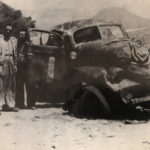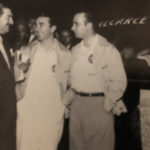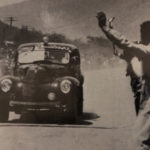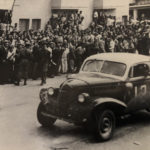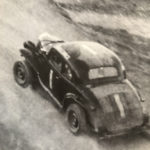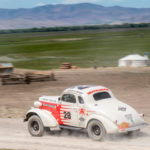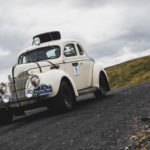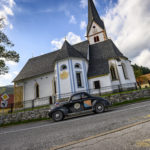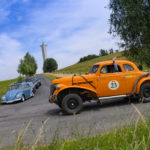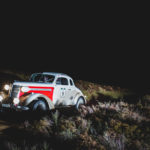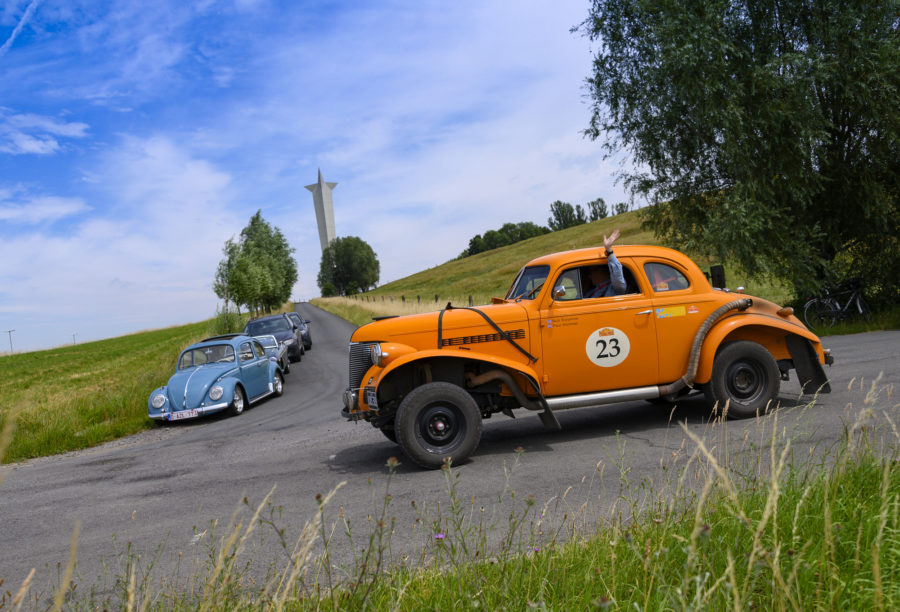
Pre war American Coupes became the main stay endurance road race and rally weapons across the Americas in the forties and fifties. Seven decades later they still roam the earth as predatory vehicles, one such 1938 Chevrolet Coupe won the 2016 ERA Rally of the Incas outright.
Their fame was sealed when the great Juan Manuel Fangio kick started his career in a Chevrolet Coupe which, due to his success, became known forever more as the Chevy ‘Fangio’. The Argentine went on to win the F1 World Championship five times, but in our fascinating yet tragic story of the 1948 Buenos Aires to Caracas road race, author Tony Watson explains how Fangio very nearly didn’t even get to become a Grand Prix driver!
This epic three week South American speed endurance road race turned out to be a battle between Chevrolet and Ford, their 1938 Coupe evenly matched with the Chevy as they still are in ERA events across the world, including the Peking to Paris Motor Challenge, and where we expect them to fight again in the 2021 Lima Cape Horn when the cars return to their roots.
The 1948 event has many parallels to the Peking to Paris, a gruelling test of man and machine over the most challenging terrain possible with rest days turning into full on motor repair days. Perils and obstacles to overcome with a great spirit of camaraderie which was also prevalent in the 1948 Buenos Aires to Caracas race. The only difference being the latter day P2P has not yet had to dodge the bullets that their historic motor sport cousins did 72 years ago.
We are very grateful to Joe Dunn the Editor of Motor Sport Magazine for his kind permission to reproduce this story from the October 2005 edition of Motor Sport.
__________________________________________________________________________

The Gran Premio de la America del Sur almost forced Fangio to quit racing
Author; Tony Watson
Monday November 8th 1948: Oscar Galvez has been leading the 5950 mile Gran Premio de las America del Sur since the first leg from Buenos Aires – nearly three weeks ago.
It is now only 420 miles to the finish line in Caracas, he is starting this final leg with a lead of two and a half hours over his nearest pursuer Juan Galvez, one of his younger brothers. No need to risk things then as, barring mechanical glitches and as long as there is sufficient fuel along the road to feed the thirsty V8 in front of him, he should be celebrating victory by early afternoon.
But temptation for a final do-or-die effort to Caracas is finding it’s way into some of his rivals last minute plans due to a hefty jackpot that is now up for grabs for the winner of this final leg. There is talk of huge prize money several tens of thousands of dollars……
This is the day’s prospect ahead of him and riding helper Federico Herrero aboard the self prepared Ford Coupe on a typically torrid South American morning whilst they wait to be flagged away.
The 1948 Gran Premio de la America del Sur or put simply, La Buenos Aires/Caracas was quite unique and without doubt the continent’s lengthiest open road race to date. By far! No special stages combined with road stages in this case. Instead there were 14 legs which were flat out all the way (spread over 20 days, five of them so called ‘rest days’ but in fact required by the crews for servicing their cars) on interminable dusty plains and over mauling, rock- strewn mountain roads. The route would wind it’s way northwards through Argentina via Bolivia, Peru, Ecuador, Colombia and right up to the Caribbean shores of Venezuela’s capital city, Caracas.
Along this tortuous route there would be a good amount of car balancing miles over perilous Andes mountain paths, usually with about 200 litres of fuel slopping about just behind the crew’s backs.
There were no fewer that 141 entries. It was now three years since the end of World War 2 and the supply of spares, especially tyres, was back to normal in South America. The event represented the chance of a lifetime, not just for the pros but also for an army of lesser-knowns wanting to take part in this one off adventure.
Drivers and their families had been pooling their resources, many of the entrants had organised huge barbeques and the occasional soccer match in their home towns to help raise funds. The local populations were happy to have assisted in paying for an entry fee. There was absolutely nothing like having a home crew in the event representing your town.
Pre event favourites included the Galvez brothers (Oscar and Juan), Juan Manuel Fangio and his great friend Domingo Marimon (father of future Maserati GP driver Onofre), with Eusebio Marcilla, Pablo Gulle, Uruguay’s Hector Supicci Sedes and several others also in the frame for victory. It boiled down to a Ford versus Chevrolet contest with Mercury, Lincoln, Buick, Plymouth, Nash and De Soto marques also represented.
The late evening start on Wednesday October 20th in downtown Buenos Aires, from the ramp in front of the Automovil Club Argentino’s mammoth building was quite a sight. Massive crowds formed human chains on both sides of the streets for mile after mile. Heading the crews off just before midnight, with number one proudly painted on his 1939 Chevrolet was the up and coming Balcarce driver Fangio accompanied by his pal Daniel Urrutia. The night was clear and there were no side winds – good news when it came to man handling the two ton, top heavy and tail happy cars in the dark.
Exiting Buenos Aires the roads continued to be engulfed by enormous crowds, the intermittent glow of the small fires along the way giving them the appearance of a never ending barbeque party with cars flashing past at 100 mph.
Fangio and Oscar Galvez fought for the lead during the initial 300 miles until the future five times World Champion encountered condenser trouble during the night. Making use of his knowledge of the roads due to his frequent journeys in the area required by his business as an undertaker, Domingo Marimon took over Fangio’s challenge for the lead. A hundred miles before Salta, after nearly 12 hours racing in 85 degrees F in arid scenery with few trees, the two were still neck and neck until two punctures delayed Marimon.
Fangio was over four hours behind after having to change the mashed differential in his car at the roadside aided by a spectator who lent him parts from his own car!
Galvez was fastest over the slow gravel roads of the second leg to La Quiaca, Argentina’s most northerly town. Typical of him, his careful planning had entailed practicing the assembly of his car’s transmission over and over again, blindfolded! After all there were no floodlights to be seen in the Andes where they were now heading. The following day the 94 remaining crews made their way into Bolivian territory en route to Potosi. 300 miles further up the road, the elder Galvez continued to lead. Meanwhile Fangio suffered a broken half shaft.
While competitors congregated for a late night supper in Potosi the mood became sombre. News had filtered through about one of the crews crashing down a precipice to their deaths.
Sunday October 24th was a 340 mile haul west towards La Paz, on Bolivian soil and still climbing towards Lake Titicaca. With engine heat and dust pouring into the cars, this time it was Juan Galvez aboard his dark blue Ford who was fastest whilst Marimon finished a minute behind, but Oscar Galvez remained ahead on aggregate despite hitting a large rock and needing to stop to repair his car’s steering.
From 40th overall Fangio dominated the next leg, an all out 340 mile drive west from La Paz to Arequipa in Peru. The day’s climb over the Andes peaking at 4600 meters above sea level, was as tough as hell. The Galvez brothers kept in front for the early miles until the climbing began. At that point Fangio stamped his authority on the proceedings after clambering past more than thirty cars.
After a rest day came a 678 mile trek from Arequipa to Peru’s capital city Lima, during which Oscar Galvez increased his advantage. However, the drums of war awaited the teams in the shape of a military coup making it’s way up from the southern region. The starting hour for the 820 mile seventh leg to Tumbes should have been at 5.00 am on Friday but the sound of gunfire around Lima meant a last minute change of plan to get the Gran Premio de la America del Sur away from the shooting as quickly as possible. The 66 remaining sleep deprived crews were hurriedly awoken and ushered off from 10.00 pm Thursday night at ten second intervals.
To cap it all, mist was blowing in from the Pacific Ocean which meant visibility was much reduced although again, Fangio gave it his all, so much so that he missed his mid-leg refuelling point. Exiting a village in the middle of nowhere just before 5.00 am with Oscar Galvez just meters behind, a left hander caught Fangio out.
The Chevrolet rolled down an embankment with spares, wheels and even a spare gearbox flying around inside the car. Fangio hung on to the steering wheel but his riding helper Daniel Urrutia had nothing to grab onto and was flung out.
Oscar Galvez overturned almost simultaneously at the very same spot. After helping Fangio out of the car he was urged by Juan Manuel to continue the event. Urrutia was found badly injured in the surrounding darkness some way from the destroyed Chevrolet. Moments later Eusebio Marcilla came to the rescue, forgetting about his own victory aspirations to carry them both to a nearby hospital, but sadly Fangio’s good friend Daniel Urrutia died shortly afterwards.
Marimon and several other drivers want to retire so as to see Fangio through his convalescence in Peru. But from his hospital bed, via a radio message, he managed to convince most of them, Marimon included, to continue.
Marimon again considered quiting the event the following day whilst on winding mountainous roads between Guayaquil and Quito in Ecuador when a broken half shaft further delayed him. Riding mechanic Pedro Duhalde convinced him to give it another chance.
The next leg was 242 miles, steep climbs at first followed by some miles on a plateau then a rapid descent into the town of Pasto now on dusty Colombian soil. Marimon fell further behind when a wheel parted company with his Chevrolet, but after retrieving it from the bottom of a precipice with another fix, he was back in action to retain third place overall several hours behind the Galvez brothers. Then it was over some relatively low altitude Andes passes and onto the Colombian capital of Bogota.
Starting the final day, Oscar Galvez’s aggregate time was just over 105 hours with the chequered flag waiting for him in Caracas, not much more than eight hours away. As the cars trickled into Venezuelan territory Juan Galvez flashed past his elder brother Oscar and disappeared over the horizon only to crash down an embankment, luckily without injury to him or his riding helper Desiderio Avila.
The final leg’s tempting jackpot had taken it’s first victim.
When Oscar arrived he tried to tow his brother out, giving his Ford’s engine a real hammering until a lorry arrived and managed to finish the job. Oscar now heard ominous noises emerging from under his bonnet, plus his clutch was now slipping. Caracas suddenly seemed just a mirage.
Victor Garcia, ninth overall, was the first to reach downtown Caracas and claim the coveted prize money at lunchtime, followed by the Chevrolets of Marcilla and Marimon. Meanwhile the local broadcaster was announcing that Oscar Galvez had stopped not far out of Caracas and that his formerly invincible bright red Ford Coupe was being pushed on uphill stretches by a spectators car. Marimon was already celebrating an unexpected second place, but now some were whispering in his ear that he could end up as the winner! Winner? Marimon shrugged it off with some hearty laughs. After all he began the day nearly five hours behind Galvez and everyone in the business knew the Ford driver was capable of repairing an engine on the roadside in much less time than that.
With darkness looming, Galvez suddenly reached the finish line in Caracas, free wheeling down the avenue towards the line, his engine well and truly silent. According to the rules, all cars must reach the finish under their own steam, the Ford’s radiator was stone cold.
This meant the victor’s laurels finally went to an incredulous Domingo Marimon, but he had little time for celebration as he soon turned around and headed off to Peru in his battered Chevrolet Coupe to see how his friend Fangio was recovering.
There he found Juan Manuel nearly two weeks after the accident, still shocked by the tragic loss of his friend Daniel Urrutia. He was considering forgetting about a career in motor sport, he was thinking about just heading back to Balcarce to concentrate on his garage business.
Thank goodness he didn’t.
Photos by Blue Passion, Will Broadhead, and Gerard Brown
